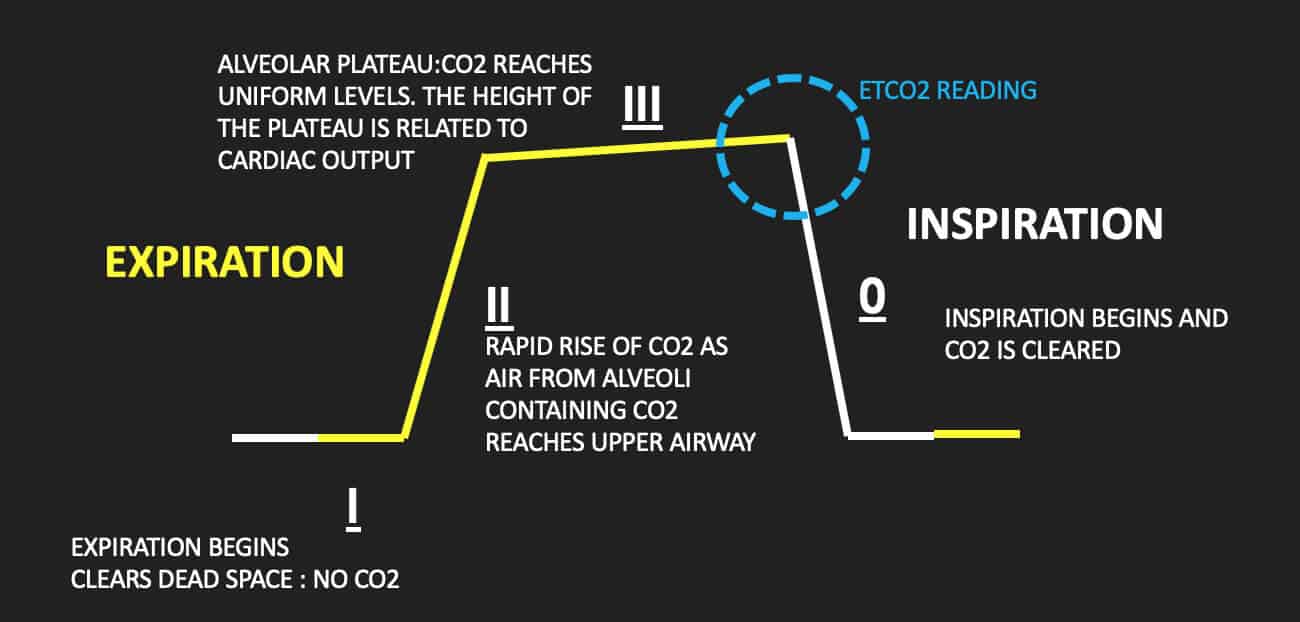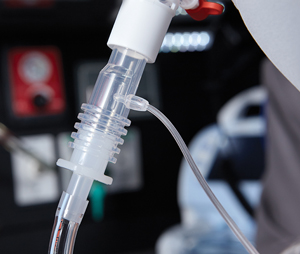low end tidal co2 after intubation
Esophageal Intubation 0 25 50 75 100 Time CO2 CO2 Esophageal Intubation After extended Bag-Valve-Mask ventilation 0 10 20 30 40 50 CO2 Procedure Perform standard interventions per protocol for managing Airway Breathing and Circulation Prepare intubation equipment including end tidal CO2 detector Depending on device the electronic. It is the measurement of CO2 at the completion of exhalation and roughly correlates to the CO2 present in arterial blood.

Waveform Capnography In The Intubated Patient Emcrit Project
For example increased dead space is seen in pulmonary embolism in pneumonia or.

. Patients randomized to NIV had higher end-tidal oxygen concentrations following intubation 88 inter-quartile range 82 to 90 vs. P 00001 and a lower incidence of arterial oxygen saturation less than 95 30 vs. The use of quantitative end-tidal capnometry to avoid inadvertent severe hyperventilation in patients with head injury after paramedic rapid sequence intubation.
The purpose of our study was to determine whether ETCO2 measurement could distinguish tracheal from esophageal tube placement. ETCO2 emergency department monitoring and critical. A low end-tidal CO2 in hypothermia.
This may result from such ventilatory problems as high mean airway pressure or inadequate exhalation time resulting in overdistention or from such circulatory problems as. The aims of this study were to determine the time to detect ETCO2 following intubation during resuscitation of infants born prematurely and whether it differed according to maturity at birth or the Apgar scores as a measure of the infants condition after birth. B beige indicates moderate levels and probable tracheal intubation.
We routinely use ETCO2 to provide information on ventilation. Detects breath to breath colour changes through a pH detector metacresol purple on filter paper changes to yellow in the presence of CO 2 Quantitative devices. The use of quantitative end-tidal capnometry to avoid inadvertent severe hyperventilation in patients with head injury after paramedic rapid sequence intubation.
Savastano S et al. An end-tidal carbon dioxide level of 10 mmHg or less measured 20 minutes after the initiation of advanced cardiac life support accurately predicts death in patients with cardiac arrest associated with electrical activity but no pulse. Normal end-tidal PCO2 is approximately.
In this study the aim was to review the applications of end-tidal carbon dioxide ETCO2 monitoring in emergency department multiple databases were comprehensively searched with combination of following keywords. 76 inter-quartile range 66 to 82. Measurement of a low ETCO 2 value 10 mmHg during CPR in an intubated patient suggests that the quality of chest compressions needs improvement.
The effectiveness of out-of-hospital use of continuous end-tidal carbon dioxide monitoring on the rate of unrecognized misplaced intubation within a regional emergency medical services system. Objectives End tidal carbon dioxide ETCO2 monitoring can facilitate identification of successful intubation. The normal values of end-tidal CO 2 is around 5 or 35-37 mm Hg.
Capnograph is an indispensable tool for monitoring metabolic and respiratory function. A semiquantitative colorimetric FEF end-tidal CO2 detector Fenem Inc New York NY was used to evaluate endotracheal versus esophageal intubation. A purple indicates low levels and probable esophageal intubation.
A high peak of the alveolar phase in poorly compliant lungs. Can the value of end tidal CO2 prognosticate ROSC in patients coding into emergency department with an out-of-hospital cardiac arrest. Alveolar dead space may be increased in most types of lung disease reflecting dysfunction at the alveolar vascular or airway level.
Silvestri S Ralls GA Krauss B Thundiyil J Rothrock SG Senn A et al. 38 mmHg or 5. End-tidal carbon dioxide reflects CO 2 concentration of alveoli emptying last.
Congratulations youre in the oesophagus. Though initially there is some CO 2 returning though the tube one finds with subsequent breaths the end tidal graph is lower and lower and the patient is getting more and more hypoxic. The beta angle is the transition from Phase III to Phase I the start of inspiration an additional phase IV terminal.
Consequently a strategy of high-frequency low-tidal volume breaths will tend to achieve less CO2 clearance for any specific total minute ventilation. Association between prehospital cpr quality and end-tidal carbon dioxide levels in out-of-hospital cardiac arrest. End-tidal carbon dioxide and defibrillation success in out-of-hospital cardiac arrest.
But ETCO2 can also provide valuable information on the adequacy of cardiac perfusion. End-tidal carbon dioxide monitoring ETCO2 has clinical uses far beyond solely determining hypo- or hyperventilation. Murphy RA Bobrow BJ Spaite DW et al.
End-tidal CO2 measurement in the detection of esophageal intubation during cardiac arrest. CO2 EtCO2 the maximum CO2 concentration at the end of each tidal breath can be used to assess disease severity and response to treatment. End-tidal carbon dioxide Et co 2 is a valuable marker of the return of adequate circulation after cardiac arrest due to medical causesPreviously the prognostic value of capnography in trauma has been studied among limited populations in prehospital and emergency department settings.
Dead-space ventilation results in ventilated alveoli with insufficient perfusion which leads to low ETco 2. The gradient between the blood CO 2 PaCO 2 and exhaled CO 2 end-tidal CO 2 or PetCO 2 is usually 5-6 mm Hg. End-tidal clearance must be evaluated in the context of the patients perfusion status.
This non-invasive monitor can give valuable information about cardiac output perfusion and ventilation. Like pulse oximetry before it alerting us to changes in oxygenation end-tidal CO2 monitoring or ETCO2 is rapidly becoming an additional vital sign. This disposable bedside detector registers three ranges of CO2 concentration.
Ensure proper rate approximately 100min Ensure proper depth with adequate releaserecoil of thorax 12 thorax or minimum 25 inches Persistently low EtCO. Measurement of end-tidal carbon dioxide ETCO2 has been used to detect accidental esophageal tube placement in noncardiac arrest situations. Capnography is also the most reliable indicator that an endotracheal tube is placed in the trachea after.
The alpha angle is the transition from Phase II to Phase III. Capnometry devices provides measurement and numeric display of end tidal CO 2 ETCO 2 Capnography provides a display of the quantity of exhaled CO 2 with time which produces a.

Waveform Capnography In The Intubated Patient Emcrit Project

Waveform Capnography In The Intubated Patient Emcrit Project

Evidence Supports Using End Tidal Carbon Dioxide To Detect Prehospital Sepsis Jems Ems Emergency Medical Services Training Paramedic Emt News

How To Read And Interpret Capnography Waveforms Infinium Medical

Waveform Capnography In The Intubated Patient Emcrit Project

3 Things To Know About Capnography And Advanced Airways Capnoacademy Capnoacademy

Waveform Capnography In The Intubated Patient Emcrit Project

Pv Card Continuous End Tidal Co2 Monitoring In Cardiac Arrest Cardiac Nursing Cardiac Arrest Medical Knowledge